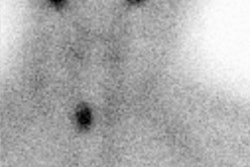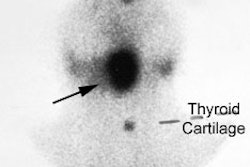J Nucl Med 2002 Jun;43(6):828-34
Stunning of iodide transport by (131)I irradiation in cultured thyroid
epithelial cells.
Postgard P, Himmelman J, Lindencrona U, Bhogal N, Wiberg D, Berg G, Jansson S,
Nystrom E, Forssell-Aronsson E, Nilsson M.
The existence of thyroid stunning (i.e., inhibited thyroidal iodide uptake
after administration of diagnostic amounts of (131)I) is controversial and is
currently a subject of debate. To our knowledge, the stunning phenomenon has not
been investigated previously in vitro. METHODS: Growth-arrested porcine thyroid
cells that formed a tight and polarized monolayer in a bicameral chamber were
irradiated with 3-80 Gy (131)I present in the surrounding culture medium for 48
h. The iodide transport capacity after irradiation was evaluated 3 d later by
measuring the transepithelial (basal to apical) flux of trace amounts of (125)I.
RESULTS: The basal-to-apical (125)I transport decreased with increasing absorbed
dose acquired from (131)I; a nearly 50% reduction was observed already at 3 Gy.
Stable iodide at the same molarity as (131)I (10(-8) mol/L) had no effect on the
(125)I transport. Cell number and epithelial integrity were not affected by
irradiation. CONCLUSION: Stunning of iodide transport is detected after (131)I
irradiation of cultured thyroid cells. The degree of inhibition of transport is
dependent on the absorbed dose.




